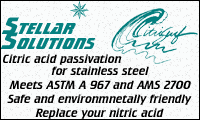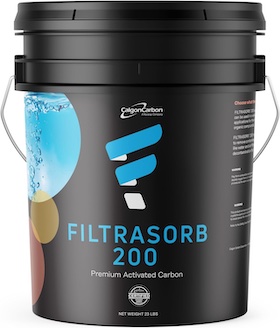
-----
Reagent Water Type IV for copper sulphate Test per AMS 2700
Q. I'm trying to source reagent water for copper sulphate
⇦ on
eBay or
Amazon [affil link] testing after passivation per AMS2700 section 3.2.1.3.1. So far I've been unable to source this requirement readily.
Is type IV really required because I was looking at ASTM A967 section 14.4.2 and it states that distilled water can be used. AMS2700 does not include ASTM A967 in the applicable documents.
Your help would be appreciated.
- Camarillo, California, USA
July 3, 2013
A. How much water do you need. Lab supply houses sell it by the jug. If you need more, there are excellent DI rigs that will give you whatever quality of water that you need. You just change out the resin/filters when the quality drops on the meter.
If you are using chlorinated water, run a prefilter with activated carbon ahead of it for longer life.
Running a small RO unit ahead of it will make it last even longer. Think of the under the sink size.
If you need lots and lots of water, then go with multiple mixed resin commercial tanks in series.
- Navarre, Florida
A. P.J.,
Thanks for pointing this out. I've read AMS 2700 before of course but it seems I always glossed over the specifics of the copper sulphate formula. Even the original MIL spec 753C (used by QQP35 and as the basis for both 2700 and A967) uses distilled water for this. I cannot fathom why the AMS committee went with D1193 reagent water when 2700 was first crafted. I am on that committee now and have a list of things to bring up the next time 2700 is up for review, I shall add this to that list.
I don't have a copy of D1193, though the ASTM page for one of the older versions (www.astm.org/DATABASE.CART/HISTORICAL/D1193-99E1.htm) happens to list out what limits are associated with the different types. IV is the option with the highest impurity amounts allowed. It would not surprise me if the vast majority of distilled water you can get easily surpasses the requirements for Type IV. However, wording the copper sulphate recipe to require type IV rather than mere "distilled water" in general implies an onus on the user to test the water for these limits or purchase from a source that certifies the limits, and that I think is quite unnecessary.

Ray Kremer
Stellar Solutions, Inc.
McHenry, Illinois

Q. I was able to source 40 L of type IV water from a lab supply company so we are good for a year.
Per SAE AS 2390 we need to use a test specimen to verify our copper sulphate test solution, our material is CRES 300 series.
We tried a small piece of 300 CRES that was machined with the batch of parts and the test showed no results (no copper looking patch). If we use a piece of steel that I found in maintenance and perform the copper sulphate test we get a clear indication of copper from the copper sulphate test. Using the steel the copper sulphate solution is good, while using the 300 CRES I get no results.
According to AS2390 I am to use an alloy in the same generic class to verify the solution. But the verification doesn't work with non-passivated 300 CRES.
If I specify a piece of steel (1020, etc.) on my process instructions I violate AS2390; if I use a piece of 300 CRES (same generic class and processed similar) I get no results, which means the solution is bad.
What do I do?
- Camarillo, California, USA
A. PJ,
It does seem like the SAE committee went out of their way to make the copper sulphate requirements obtuse and difficult.
I don't have a copy of AS2390 handy, but 2700 says "Test specimens of any convenient size, made from materials in accordance with AS2390 representing transformation hardening steels". Since your 300 series parts are not a transformation hardening grade, I do not think this is actually saying you need to use the same alloy as your parts. Something under the martensitic category should be fine here.
Since 2700 does not use the phrase "the same generic class of alloy" at all, I'm not sure how AS2390 is expected to apply here.

Ray Kremer
Stellar Solutions, Inc.
McHenry, Illinois

September 24, 2013
Need Type IV Reagent Water for ASTM D1193
RFQ: Hi, I'm currently in the need of Type IV reagent water based on ASTM D1193, but I'm having a little trouble finding a source. Can you please let me know where you got yours?
Thanks in advance for your help
- Nogales, Arizona USA
June 24, 2014
A. The easiest way to get the water in small quantities is to buy a disposable Mixed Bed Ion Exchange cartridge from a lab supply company. These have a color change so you can tell when they are exhausted and need to be replaced. The water will meet or be even better than Type IV specifications in quality.
Lyle Kirmanconsultant - Cleveland Heights, Ohio
June 27, 2014
Q, A, or Comment on THIS thread -or- Start a NEW Thread
